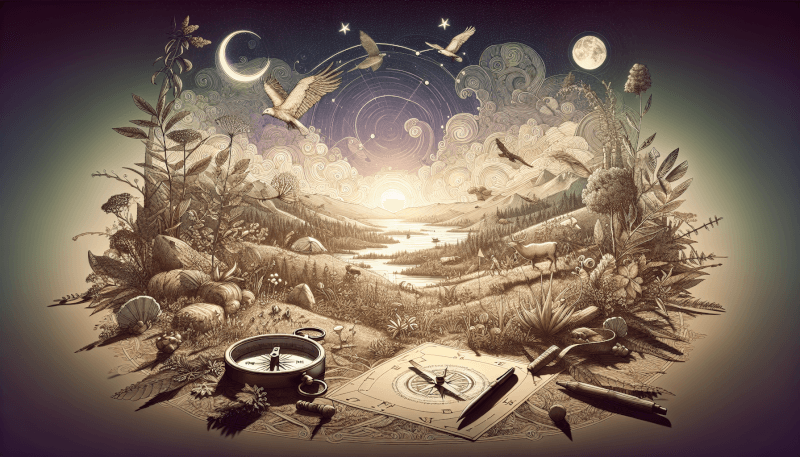Imagine being able to navigate through unfamiliar terrain without the need for a compass or GPS. Picture yourself effortlessly finding your way through the wilderness with nothing but the knowledge of the natural world to guide you. In “The Natural Navigator: A Watchful Explorer’s Guide To A Nearly Forgotten Skill,” you will uncover the secrets of ancient navigational techniques that have been nearly lost to modern technology. Join the author on a captivating journey as they reveal the wonders of observing nature’s cues and teach you how to become a skilled natural navigator. Get ready to rediscover the lost art of finding your way through the world with a keen eye and an open mind.

Introduction
What is natural navigation?
Natural navigation is the art of finding your way in the outdoors by observing and interpreting natural clues and signs. It relies on our innate ability to navigate using our senses, intuition, and an understanding of the environment. Instead of relying on modern technology like GPS or maps, natural navigation encourages us to connect with nature and develop a deeper understanding of our surroundings.
Why is it a nearly forgotten skill?
In today’s modern world, the reliance on technology for navigation has diminished our connection to the natural world. With the convenience of smartphones and GPS devices, many people have forgotten or never learned the traditional skills of natural navigation. This has resulted in a lack of awareness of our surroundings and a diminished sense of self-reliance. However, there is a growing movement towards rediscovering these forgotten skills and rekindling the art of natural navigation.
History of Natural Navigation
Ancient civilizations and natural navigation techniques
Natural navigation techniques have been utilized by ancient civilizations for thousands of years. In the absence of modern technology, early humans relied on their senses and observations to navigate the world. For example, ancient Polynesians used the stars, waves, and wind patterns to navigate across vast expanses of the ocean, while the Native American tribes often relied on the movement of plants and animals as a wayfinding tool.
Role of natural navigation in early explorations
Natural navigation played a crucial role in the early explorations of the world. Many famous explorers, such as Christopher Columbus and Captain James Cook, relied on their knowledge of celestial navigation and natural landmarks to navigate uncharted territories. The ability to read the stars, understand wind patterns, and interpret the behavior of animals and plants allowed these explorers to venture into the unknown with confidence.

Tools and Techniques for Natural Navigation
Using the sun and shadows for direction
One of the most fundamental techniques in natural navigation is using the sun and shadows to determine direction. By observing the position of the sun and the length and direction of shadows, one can easily determine east and west, and even estimate the time of day. This technique is particularly useful when the sun is visible, making it an essential skill for any natural navigator.
Reading the stars and celestial navigation
Stargazing and celestial navigation have been used for centuries to determine direction and position. By identifying constellations and tracking the movement of stars across the night sky, natural navigators can determine their latitude and, to some extent, longitude. The North Star, for example, has long been used as a reliable point of reference for navigation in the Northern Hemisphere.
Understanding the movement of plants and animals
The behavior and movement of plants and animals can provide valuable information for natural navigation. For instance, moss tends to grow on the north side of trees in the Northern Hemisphere, providing a natural compass. Additionally, birds often migrate in predictable patterns, allowing natural navigators to track their movements and follow their flight paths.
Interpreting wind patterns and cloud formations
Wind patterns and cloud formations can be used to determine direction and even predict weather changes. Natural navigators learn to observe the movement of clouds, the shape of cumulus clouds indicating fair weather, or the presence of cumulonimbus clouds indicating potential storms. Similarly, the direction and strength of the wind can help determine direction when navigating in open spaces.
Utilizing natural landmarks and topography
Natural landmarks, such as mountains, rivers, and coastlines, can serve as reliable markers for navigation. By studying the topography of an area, natural navigators can create mental maps and navigate based on the understanding of the surrounding land features. This includes noticing the shape and height of mountains, the flow of rivers, and the direction of coastlines.
Developing a Natural Navigator’s Mindset
Heightened observation skills
To become a skilled natural navigator, one must develop keen observation skills. This involves paying attention to details in the environment, such as the position of the sun, the behavior of animals, and the movement of clouds. By actively engaging with the surroundings, a natural navigator can gather valuable information to aid in their navigation.
Developing a sense of direction and orientation
A sense of direction and orientation is a key component of natural navigation. By regularly practicing and honing this skill, one can develop an innate sense of which way to go even without external cues. This sense of direction is cultivated through observation, experience, and a deep connection with the natural world.
Enhancing spatial awareness
Spatial awareness is crucial for natural navigation. It involves understanding one’s position in relation to the surrounding environment and being able to interpret spatial relationships between objects. By cultivating this skill, a natural navigator can create a mental map of their surroundings and navigate with confidence.
Learning from the environment
The environment itself becomes a teacher for a natural navigator. By observing and learning from nature, one can understand the patterns, rhythms, and cycles that govern the natural world. This knowledge can be applied to navigation, as nature provides a wealth of clues and signs to guide the way.

Benefits of Natural Navigation
Connecting with nature and the environment
Natural navigation allows individuals to forge a deep connection with nature and the environment. By relying on their own senses and observation skills, natural navigators become intimately aware of their surroundings and develop a profound appreciation for the wonders of the natural world.
Building self-confidence and self-reliance
Being able to navigate the outdoors without relying on technology builds self-confidence and self-reliance. Natural navigators gain a sense of empowerment knowing that they can depend on their own skills and abilities to find their way. This newfound self-confidence often spills over into other areas of life, leading to a greater sense of self-assurance.
Improve problem-solving skills
Natural navigation requires constant problem-solving and critical thinking. From interpreting wind patterns to determining the position of stars, natural navigators must use their knowledge and observations to make informed decisions. These problem-solving skills honed through natural navigation can be applied to various aspects of life, leading to enhanced problem-solving abilities overall.
Developing a deeper understanding of the natural world
By engaging with nature and actively observing the environment, natural navigators develop a deeper understanding of the natural world. They learn to appreciate the interconnectedness of all living things and the delicate balance of ecosystems. This understanding fosters a sense of stewardship and environmental awareness.
Challenges and Limitations of Natural Navigation
Necessity of practice and experience
Natural navigation is not a skill that can be learned overnight. It requires practice, experience, and a deep understanding of the environment. Developing the necessary observational skills and intuitive understanding of natural clues takes time and patience.
Reliance on specific environmental conditions
Not all natural navigation techniques can be applied in every environment or situation. Some techniques, such as celestial navigation, require clear skies and a certain level of astronomical knowledge. Others, like using the sun and shadows, are dependent on daylight and unobstructed views. Natural navigators must adapt to the specific conditions of their environment and adjust their techniques accordingly.
Potential for errors and misinterpretations
Even experienced natural navigators can make mistakes or misinterpret the clues and signs nature provides. The natural world is complex, and factors like weather conditions or unfamiliar surroundings can lead to errors in navigation. It is important for natural navigators to recognize and account for these potential limitations.

Applying Natural Navigation in Modern Times
Useful applications for outdoor activities
Natural navigation skills can enhance various outdoor activities, such as hiking, backpacking, or camping. By relying on natural clues and signs, outdoor enthusiasts can navigate trails, find water sources, and determine their position without depending solely on technology. This allows for a more immersive and connected experience in nature.
Navigation without reliance on technology
In an age where technology is often relied upon for navigation, having natural navigation skills provides a backup plan in case of technological failures or limitations. Natural navigators can confidently explore and travel without fearing the loss of GPS or phone signal. This sense of self-reliance is invaluable in remote or unfamiliar areas.
Incorporating natural navigation skills into everyday life
Natural navigation is not limited to outdoor adventures; it can also be applied to everyday life. Simple techniques like observing the direction of shadows can help orient oneself in unfamiliar city streets. Paying attention to wind patterns and cloud formations can aid in predicting weather changes even in an urban environment. Natural navigation allows us to reconnect with our surroundings, no matter where we are.
Learning Natural Navigation
Finding resources and courses on natural navigation
There are various resources available for those interested in learning natural navigation. Books, online courses, and workshops offer valuable instruction and guidance on developing these skills. Some resources focus on specific techniques, while others provide a comprehensive overview of natural navigation as a whole.
Joining outdoor clubs and communities
Joining outdoor clubs and communities is an excellent way to connect with like-minded individuals and learn from experienced natural navigators. These groups often organize outings and workshops where members can practice and refine their natural navigation skills together. Additionally, being part of a community provides an opportunity for sharing knowledge and experiences.
Practical exercises for developing natural navigation skills
Practical exercises are an essential part of learning natural navigation. Engaging in activities such as stargazing, tracking animal movements, or studying cloud formations can help develop observation skills and enhance understanding. Regular practice and experimentation in the outdoors allow for the application of natural navigation techniques in real-life scenarios.

Preserving the Skill of Natural Navigation
Recognizing the importance of traditional navigation techniques
While modern technology has its merits, recognizing the significance of traditional navigation techniques is vital. Natural navigation is not just a skill; it is a cultural heritage passed down through generations. By valuing and preserving these techniques, we ensure that the art of natural navigation is not lost to future generations.
Documenting and sharing knowledge of natural navigation
Documenting and sharing knowledge of natural navigation is essential for its preservation. This can be done through books, articles, videos, or online platforms where experienced natural navigators can share their insights and techniques. By making this knowledge accessible, we enable others to learn and appreciate the art of natural navigation.
Conclusion
Embracing the art of natural navigation
Natural navigation offers a unique and enriching way to explore the world around us. By relying on our innate senses and observation skills, we can connect deeply with nature and develop a profound understanding of our environment.
Continuing the tradition of exploring the world through observation and intuition
By embracing and practicing the skills of natural navigation, we continue a long-standing tradition of exploration rooted in observation and intuition. We keep alive the art of navigating without solely relying on technology, allowing us to forge a stronger bond with nature and ourselves. So, go out, observe, and navigate the world through the lens of a natural navigator.


